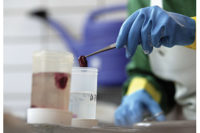Gentlemen, start your test kits

Although the USDA does not yet know the prevalence of the 6 non-O157 E.coli’s, or the incidence of illness caused by these pathogens, they are committed to the announced date of June 2012 to enact their decision.
Being the only Canadian in the room, I felt I had nothing to lose by asking our legislative friends to the South why. Why make these other 6 E.coli’s adulterants? For me it made no sense. As per the CFIA’s response, which states that given you have a recognized HACCP program that has steps in place to control E.coli O157:H7 (i.e. proper dehiding procedures and microbiological interventions), there is no need to make more strains adulterants. In fact, the latest statistics have shown a downward trend in illness caused by E.coli O157:H7 in ground beef. Finally, both USDA and CFIA have the power to recall any product due to illness regardless if the underlying pathogen responsible is deemed an adulterant.
Our hosts looked to the end of the table where I uncomfortably sat, and in a calm deliberate voice they said, “Why, why make 6 more E. coli’s adulterants? It’s simple, yes, sure, while rates of illness due to E. coli O157:H7 in ground beef are down, the fact remains, there are still incidents which means there are still harmful bacteria getting through the system.”
Still bewildered I pressed on. “If you already know that bacteria is getting through the system based on the current testing for E.coli O157:H7, what more is additional testing going to do – make your hypothesis more right?”
Am I wrong? Harvesters are already testing every lot of boneless beef and trimmings destined for grinding for E. coli O157:H7 prior to shipping. From these tests, the industry has acted and implemented a multiple hurdle approach in order to eliminate deadly pathogens from the beef supply. Yet, despite all of our best collective efforts, there are still reported illnesses due to E. coli in ground beef. So, what do we do now?
While I appreciate the USDA /FSIS and CFIA’s historical move to focus their inspections on harvest, specifically on proper hide removal and the use of microbiological interventions, I’m yet unsure of the logic of more legislation. This will lead to more testing on both the part of the industry and our governments, which will inevitably lead us to the same conclusion; that there is still bacteria getting through the harvest process.
Look, if we are already employing frequent testing in order to validate our processes in harvest and have determined we have not achieved zero incidence of E. coli in ground beef, why don’t we take those dollars and instead of investing them in additional testing to find out what we already know, let’s use them for joint research (government and industry) to discover and employ a technology that will result in a pasteurized carcass.
Testing is a great way to validate that your interventions and good manufacturing practices are effective or in some cases ineffective. The hard, cold reality is, more testing won’t lead us to a new conclusion, to information we do not already know, or, to new innovative ways to make the North American beef supply safe; it never has. It is people, not test kits, working together in industry and government for a common goal, a common good that what will make the difference.
So let’s take all those dollars that will now be spent in drafting new legislation, training inspectors and QA people, in changing HACCP programs, in creating test kits, in testing product and instead, use those resources to set up a brain trust, the best from the industry and government. Have them focus on a common goal, to come up with innovative ways and technologies that will result in pasteurized beef that will still have the same great taste that we enjoy today.
“A man should look for what is there and not for what he thinks it should be.” Albert Einstein.
Looking for a reprint of this article?
From high-res PDFs to custom plaques, order your copy today!





